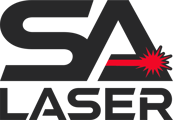Manage Layers and Operations with Ease Using the LightBurn Color Palette
The Color Palette in LightBurn is a powerful tool that assigns layers to your graphics, enabling precise control over operations like cuts and engravings. These colors do not represent the final product's colors but serve to differentiate layers and operations needed to complete your project.
Using the Color Palette
Assigning Colors to Graphics
- Purpose: Assign colors (layers) to graphics in your Workspace for managing operations.
- Convention: Bright red is often used for cuts, while black is used for engravings, though you can customize this as needed.
Adjusting Layer Settings
After assigning colors, you can configure their settings in two places:
- Cuts / Layers Window: Reorder layers and adjust basic settings.
- Cuts Settings Editor: Access advanced settings for each layer.
Accessing the Color Palette
The Color Palette is located along the bottom of the Main Window by default but can also be docked to the left side of the Workspace.
![]()
Restoring the Color Palette
- If closed, go to Window → Color Palette to re-enable it.
- To restore all toolbars and windows to their default positions, select Window → Reset to Default Layout.
Tip: LightBurn’s layout is highly customizable. For details on enabling/disabling toolbars or rearranging the layout, see Customizing the LightBurn Window.
Customizing Colors
Setting the Color for New Objects
- With nothing selected, click a color in the Color Palette.
- All new shapes will be created in that color and assigned to the corresponding layer.

Changing the Color of Existing Objects
- Select one or more objects in your Workspace.
- Click a color in the Color Palette to assign them to that color/layer.

Tool Layers
The last two entries in the palette, labeled T1 and T2, are special Tool Layers. These layers are non-output layers that won’t be sent to the laser.
Uses for Tool Layers:
- Defining material boundaries.
- Creating guidelines for alignment.
- Applying a Path to Text without outputting the path.
- Applying a Mask to an Image.
Importing Graphics from Other Software
When importing graphics, LightBurn matches the file's colors to its default palette. Using exact color matches ensures proper layer assignment.
RGB and Hex Codes for LightBurn's Color Palette
Below is a table of RGB and hex values for LightBurn’s layer colors, enabling accurate color assignment for software without native palette support.
| Layer | RGB Values | Hex Values |
|---|---|---|
| 00 | rgb(0, 0, 0) | #000000 |
| 01 | rgb(0, 0, 255) | #0000FF |
| 02 | rgb(255, 0, 0) | #FF0000 |
| 03 | rgb(0, 224, 0) | #00E000 |
| 04 | rgb(208, 208, 0) | #D0D000 |
| 05 | rgb(255, 128, 0) | #FF8000 |
| 06 | rgb(0, 224, 224) | #00E0E0 |
| 07 | rgb(255, 0, 255) | #FF00FF |
| 08 | rgb(180, 180, 180) | #B4B4B4 |
| 09 | rgb(0, 0, 160) | #0000A0 |
| 10 | rgb(160, 0, 0) | #A00000 |
| … | … | … |
| T1 | rgb(243, 105, 38) | #F36926 |
| T2 | rgb(12, 150, 217) | #0C96D9 |
By mastering the Color Palette, you can streamline your workflow, optimize layer assignments, and ensure precise control over your laser cutting and engraving projects.
